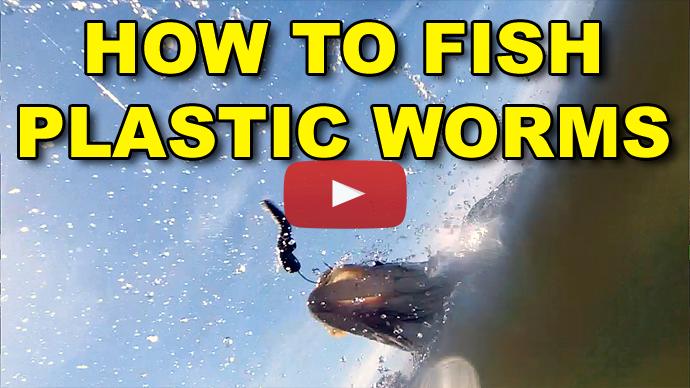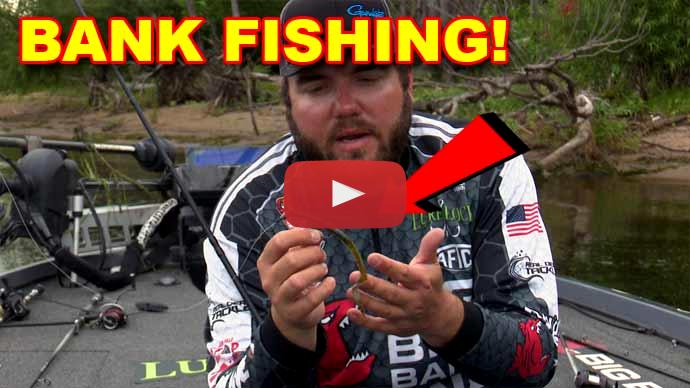All right, so let's talk a little bit about fishing Texas rigged plastic worms from the shore. This here is a...It's a 7 inch B2 worm from Big Bite Baits, one of my favorites. And I wanna talk a little bit about how to fish it throughout the spring, summer and fall seasons. First of all, what I have here, this is a 7 foot 2, is it? Yep, 7 foot 2...7 foot 3 medium heavy St. Croix Rod. This is a legend tournament rod. But this is a medium heavy power fast action rod. And paired with it, I've got myself a nice Shimano reel. This is a 6.3 to 1 reel, and I'm using straight fluorocarbon line, 15-pound InvizX Flourocarbon line. I'm not using braid or anything like that. And the reason being it's extremely versatile.
This rod is like the jack of all trades. You can use this rod for anything really, for bass fishing. I mean, you can tie on any kinda lure you want for the most part, and you can use it for a variety. So, that's great when you're fishing from the bank, you need versatility. Line, same thing. Braid is more technique specific. Braid doesn't work as well. Say for example, you're throwing in woody cover. Braid likes to dig into that wood. Or if you're throwing around riprap and rocks, it tends to get nicked and frayed a lot more than fluorocarbon line. Fluorocarbons is kind of a universal jack of all trade. Fifteen pound again, that's just sole versatile. This setup with 3/0 Gamakatsu extra wide gap hooks, standard wire, nothing fancy there. And then I'm using a tungsten weight.
Here, I'm using a quarter ounce tungsten weight because this worm...See how thin that is? It doesn't have a lot of water resistance. So, if you use a heavy weight, it's just gonna go right through the water column and that's not what you want. You want a nice slow fall through the water column. So, an eighth ounce through quarter ounce weight typically will suffice. Sometimes you might want to go to a three eighths if you're throwing in some heavy bushes and you wanted to get it down in the bushes. That is about as heavy as I'd go for the most part during the spring, summer, and fall. So, fishing it. Well, the best way to do this is you just cast out there and let the worm fall down, just straight down. Peel off some line off the rod. Don't cock the handle after you've made the cast. Instead give it some slack line, then cock the handle. And watch that line where it enters the water. Because here, a lot of times, you know, if a fish bites it, you won't feel it because you're on slack line so you have to watch for it. Watch that line, see if it does a twitch or bounce, something like that. That's a fish on the other line. Or sometimes the line it's slowly sinking in the water and then suddenly it speeds up.
Ooh. Well, something had to grab it to do that. So, there's a fish on the line. And if once it hits the bottom, reel up to it and lift up a little bit and feel, and oftentimes you're lines are swimming one way or the other. Well, a fish has it, so be ready to set the hook right away. And then finally, once it does hit the bottom, you lift up and you don't feel the fish, you don't feel the weight, you don't feel something tugging back. What you wanna do is lift up on the rod and then drop the rod. And you're not reeling, you're just lifting it up and dropping it back down. So, you're hopping it up the bank towards you. So, you're just casting out deep to shallow and just work it up. And you might have to reel up some slack eventually as it gets closer and closer to you. But the idea here is you don't want it to jump too much. As a matter of fact, when the water's really cold, say in the early spring or in the late fall, I like to cast out and actually drag it. I'll just take the rod, I'll just slowly pull it. That gives me an idea of how far I've moved it, is just by watching how far that rod tip moves. And I'll let it drag on the bottom and give it long pauses in between. That's what I want. Just 5 seconds to 30 seconds pause and wait. Sometimes the fish will pick it up while it's not even moving. Just kind of a dead stick. And then you give it a little bit more movement, 5 inches, maybe 8 inches movement.
Let it pause, as you work it back up the bank towards you. That works great when it's cold. A little bit warmer out, sometimes what I'll do is I'll cast out and just do a steady slow retrieve, just reel it back in. Swimming that worm back up over the top of the weeds, back up over any rocks or anything that's in the way between you and the water. And oftentimes that's where the fish are hiding and they'll come up out and blast it. You really can't fish crankbait sometimes from the shoreline because it'll get hung up. But you can fish a Texas rig worm just like that. So, think out of the box. You can fish it just like you would a crankbait and not get hung up in those weeds and stuff around you. So, that's an excellent way to catch fish. And then finally, one other way I like to do is throw it out there and swim it back to me, swim it over the surface. This is where you use a real lightweight, like an eighth ounce weight, but slow. Throw it out there, let it land on the surface and reel it back in so it just kind of swims across the surface.
An especially good time to do this is in the late spring, throughout the summer and even throughout mid-fall. This is an excellent way to catch fish. They're used to seeing buzz baits and other topwater baits, but they're not used to seeing a plastic worm swimming along. It looks like a little snake. You get a lot more bites that way, so little tip there. The only exception when I'm not doing it like this is during the actual spawn. During the spawn, then I'll hang up this bait casting rod and reel and I'll go to a spinning outfit. I'll go weightless on the worm and I'll lighten up. I'll use 10-pound line. It's still a medium heavy 7 foot 2, 7 foot 3 rod. But now, with a real light bait, the idea here is to cast over and past the bed. It's gonna have a nice light splash down now because it doesn't weigh a whole lot. It's gonna slowly sink and you work that bait towards the nest as it's sinking. So, it almost looks like it's swimming towards the nest. And that often elicits a strike out of the bass. But more important than that is the stealthy approach. When you're fishing beds, a lot of times the beds are right up against the bank. So, don't walk up on the bank this time of year. During the spawn get away from the edge of the shore, like 20, 30 feet away. And see if you can't spot a bed from there and make a long cast to it that way.
Or work away from getting to the shoreline but you're now 20, 30 feet away from it on the shore, and cast parallel to the shore up to it. But you wanna make sure that you're away from it. You don't wanna spook that bass. And when you walk up on the bank, they can feel the vibration on the ground underneath or hear you or even see you, and that can spook them. So, stay away from the shoreline, especially during the spawn and make those long casts. But even during the rest of the year when you're fishing, when you change positions, you move into a different spot, if you can, get away from the shoreline, come around and work your way back to the spot where you want to fish. Not walk along the shoreline, spook a bunch of fish. Also pay attention to your shadow. You know, a day like this, my shadow's over here so I don't want to work my way this way because now my shadow's in front of me. The fish might be alert to your presence. So, instead, go that way so your face is in the sun and you're not having your shadow in front of you. So little subtle things like that make a big difference when you're fishing from the shore. And that's how I would do it with a Texas rig plastic worm. Hope that helps. For more tip...Wait, hold on, hold on. If you watched the video this long, then you for sure don't wanna miss these two videos. All right. Now this one I handpicked for you because I think this is the one you're gonna wanna see next, but this is the one that YouTube thinks that you should watch. Either way, I'm in both of them. So, I'll see you in a few seconds.



